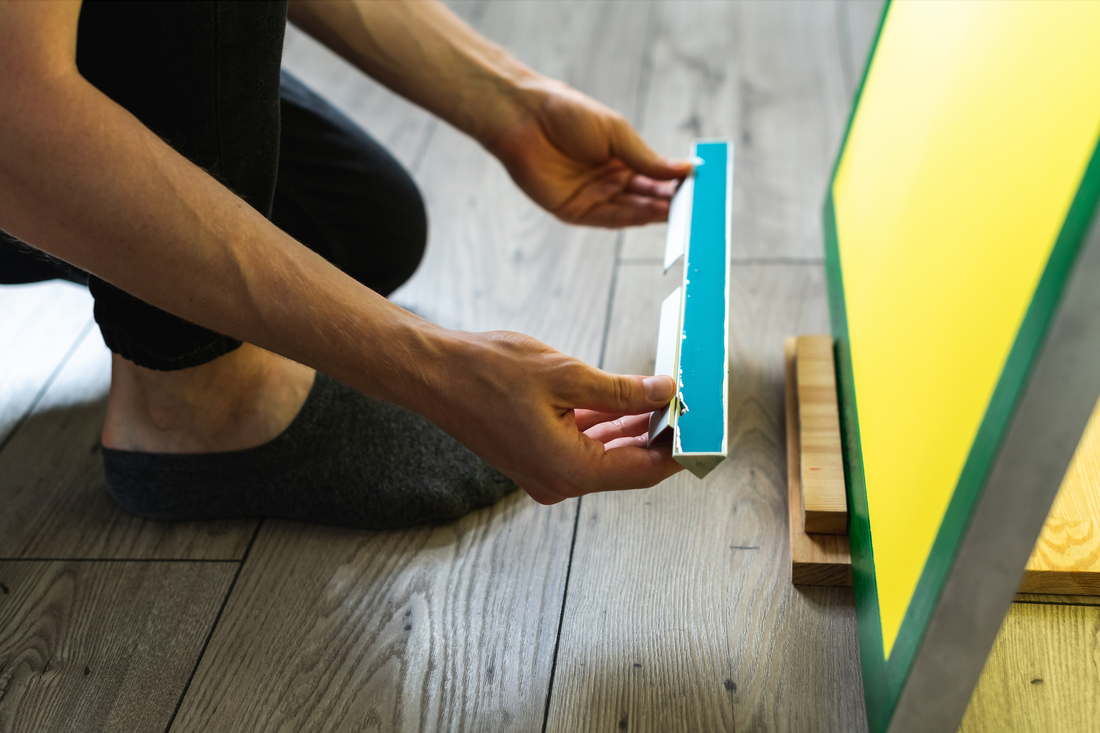Introduction to Screen Printing Emulsion
Screen printing is an age-old technique that has evolved over time to become a popular method for creating custom designs on various materials. Central to the screen printing process is the use of emulsion—a light-sensitive liquid that coats the screen and aids in the creation of a stencil. This ultimate guide will walk you through the ins and outs of screen printing emulsion, providing helpful tips, tricks, and insight along the way.

Cropped view of stencil for serigraphy on floor near artisan holding squeegee with light sensitive emulsion
Types of Screen Printing Emulsions
Screen printing emulsions fall into three main categories, each with its unique properties and advantages:
Photopolymer Emulsion
Photopolymer emulsions are pre-sensitized, meaning they are ready for use straight out of the container. These emulsions are known for their fast exposure times and excellent resolution, making them a popular choice for professional screen printers.
Diazo Emulsion
Diazo emulsions require the addition of a diazo sensitizer to become light-sensitive. These emulsions are more affordable and offer a wide exposure latitude, making them a great option for beginners and those working with a limited budget.
Dual-Cure Emulsion
As the name suggests, dual-cure emulsions combine the properties of both photopolymer and diazo emulsions. These emulsions offer excellent resolution, durability, and a wide exposure latitude, making them a versatile choice for various screen printing applications.
Preparing the Screen for Emulsion
Before applying the emulsion, ensure the screen is clean, degreased, and free of any contaminants. Use a mesh degreaser to remove oils, dirt, and residue that may interfere with the emulsion's adhesion to the screen.

Cropped view of craftsman holding squeegee while applying photographic emulsion for screen printing
Applying the Emulsion
Coating Techniques
There are two primary methods for applying emulsion to the screen: the scoop coater and the direct pour method. The scoop coater provides a more consistent and even coat, while the direct pour method is faster but may result in an uneven application.
Coating Thickness
The thickness of the emulsion coating can significantly impact the final print quality. Thicker coatings may take longer to expose but can produce better ink coverage, while thinner coatings can lead to pinholes and other print defects.
Drying the Emulsion
After applying the emulsion, it's crucial to dry the screen properly. Place the screen in a horizontal position in a clean, dust-free, and light-tight environment. Ideally, the temperature should be between 86°F and 104°F, and the humidity should be below 40%.
Exposing the Screen
To create a stencil, the emulsion-coated screen is exposed to UV light. Exposure time varies depending on the emulsion type and light source. It's essential to conduct exposure tests to determine the optimal exposure time for your specific setup.
Post-Exposure Processing
Washing Out the Screen
After exposure, the screen must be washed out to remove the unexposed emulsion, revealing the stencil design. Use a pressure washer or high-pressure spray nozzle to remove the emulsion gently. Be sure to hold the screen at an angle to allow the water to flow away from the stencil.

Reclaiming the Screen
Once the print job is complete, you can reclaim the screen for future use. Use a screen printing emulsion remover to dissolve the remaining emulsion, followed by a high-pressure wash to clean the screen thoroughly.
Printing Techniques
Manual Screen Printing
Manual screen printing involves using a squeegee to push ink through the stencil onto the substrate. This method is best for small-scale projects, as it provides the most control over the printing process.
Automatic Screen Printing
Automatic screen printing machines use pneumatic or electric mechanisms to apply ink to the substrate. This method is ideal for large-scale projects, as it provides consistent results and faster production times.

Troubleshooting Common Issues
Common screen printing emulsion issues include pinholes, under-exposure, and over-exposure. To avoid these issues, ensure proper emulsion application, adequate drying, and optimal exposure time.
Screen Printing Emulsion Tips and Tricks
- Use a sharp scoop coater for even emulsion application.
- Control humidity and temperature during drying to prevent emulsion issues.
- Store emulsions in a cool, dark place to prolong shelf life.
- Conduct regular exposure tests to fine-tune your process.
- Always degrease the screen before applying emulsion to ensure proper adhesion.
Choosing the Right Emulsion
Selecting the right emulsion depends on factors such as the ink type, mesh count, and desired print quality. Consider your specific printing needs and consult with emulsion manufacturers to make an informed decision.
Safety and Environmental Considerations
When working with screen printing emulsions, always wear appropriate safety gear, such as gloves and goggles. Dispose of emulsion waste according to local regulations to minimize environmental impact.
Conclusion
Mastering screen printing emulsion is crucial for producing high-quality prints. By understanding the different emulsion types, proper application techniques, and troubleshooting tips, you can elevate your screen printing skills and create stunning designs.
Frequently Asked Questions
- What is the shelf life of screen printing emulsion?
The shelf life of screen printing emulsion varies depending on the type and storage conditions. Generally, unopened emulsion containers can last up to a year or more if stored in a cool, dark place.
- Can I mix different types of emulsions?
Mixing different emulsion types is not recommended, as it can lead to unpredictable results and potential issues during the screen printing process.
- How can I remove dried emulsion from a screen?
To remove dried emulsion from a screen, use a dedicated emulsion remover and follow the manufacturer's instructions for proper application and removal.
- Do I need to degrease my screen every time I apply emulsion?
Yes, degreasing the screen before applying emulsion is essential to ensure proper adhesion and prevent issues during the printing process.
- Can I reuse a screen after reclaiming it?
Yes, after properly reclaiming a screen, it can be reused for future print jobs.
Equipment
Unveiling the Best Screen Printing Machines for Beginners: Your Ultimate Guide
How to Choose the Right Screen Printing Press for Your Business: A Comprehensive Guide
The Ultimate Screen Printing Kit Buying Guide
Ink
A Beginner's Guide to Screen Printing Inks
Why Water-Based Screen Printing Ink is the Future
The Benefits of Using Discharge Screen Printing Ink
Screen
How to Choose the Right Screen Printing Mesh for Your Project
Everything You Need to Know About Screen Printing Frames
The Ultimate Guide to Screen Printing Emulsion
Technique
7 Essential Screen Printing Techniques for Beginners
How to Screen Print on Fabric: A Beginner's Guide
The Basics of Screen Printing on Paper
Service
Get Custom Screen Printing for Your Business or Event
Find Screen Printing Services Near You
The Best Online Screen Printing Services for Your Business
Supplies
The Essential Screen Printing Supplies You Need
How to Remove Screen Printing Ink from Your Screens
The Ultimate Guide to Screen Printing Squeegees

